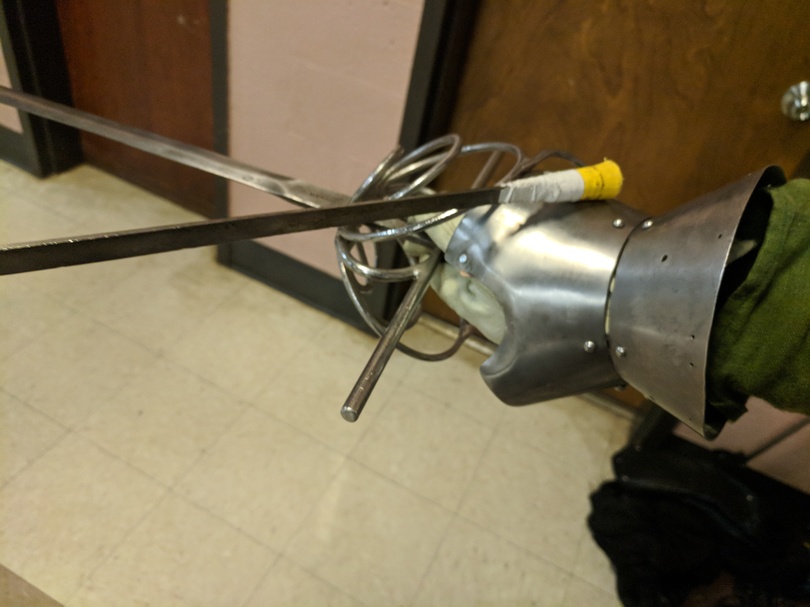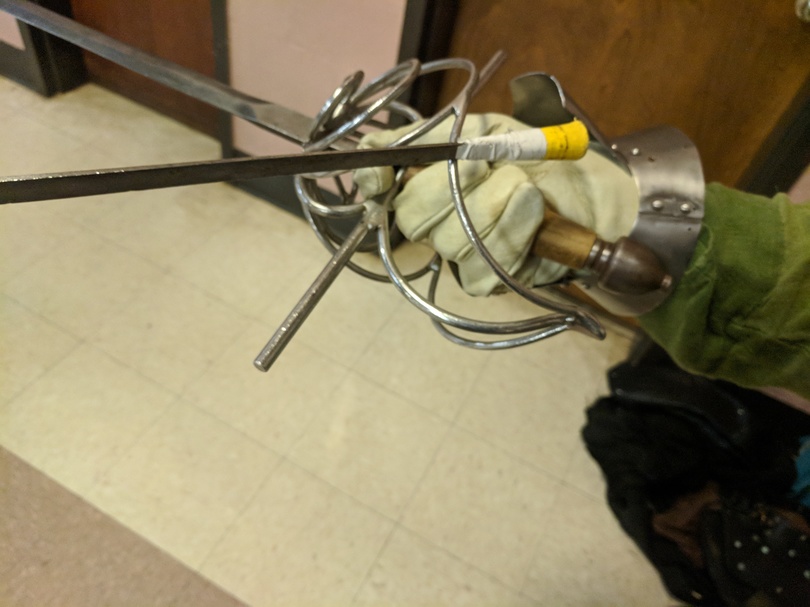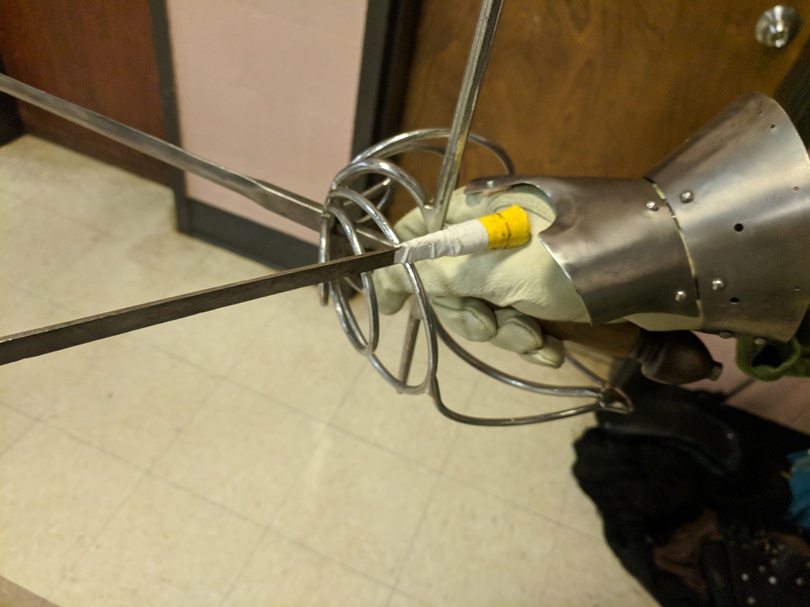Society Rules Update - April 2018
- Latest Society Rapier Marshal changes
- Requirements
- Inspection Procedure
- How will this impact you?
- Frequently asked questions
- Armor that meets these requirements
- Instructions for making equipment
Author: Master Brian de Moray, KRM
Last Modified: 2025-09-18
Revision:
Latest Society Rapier Marshal changes
The Society Rapier Marshal (SRM) published an approved update to the society rapier rules. This update includes additional requirements for hand protection for those participating in Cut & Thrust. These rules will not be enforced until the start of Pennsic 2018 (July 27th, 2018). As such, you have a short period of time to bring your kit into compliance with the new rules.
Specifically, the rules have the following additional requirements:
For cut and thrust rapier, hands and wrists require additional protection from being struck by percussive blows:
a. Areas of the backs of gloved hands, fingers and thumbs, to one inch above the wrist of both arms not protected by a hilt, parrying device, or rigid armor must, at a minimum, be protected by an additional layer of 1/4" open cell foam or equivalent resilient padding.
b. If any combatant is using a two-handed weapon, all combatants in the bout must have rigid protection for areas listed in 2.D.v.a. Examples of acceptable protection include (but not limited to):
i. Gauntlets or demi-gauntlets made of rigid material covering areas not protected by the weapon's guard.
ii. Commercial products such as Koning gloves, SPES Heavy gloves or hockey gloves which satisfy these requirements. (Note: Blatantly modern gloves are discouraged at official events and practices without attempting to cover logos and modern materials.)
The wording could use work, but evidence collected from a society level shows a trend that needed addressed. In the last three years, 811 C&T combatants received 18 reported hand injuries. In contrast, 4159 heavy rapier combatants received 5 reported hand injuries in the same time period. Additionally, our kingdom accounts for 3 out of the 18 injuries reported in the last 3 years, and so our kingdom is not excluded from the trend that needs corrected.
When evaluating protection needed, please understand the additional protection is intended to address percussive blows, not thrusts.
Requirements
Marshals inspecting C&T armor to follow these new rules will need to do the following:
- For any fight where either combatant is using a two-handed weapon, both fighters must have rigid components that cover the back of their wrists (to one inch past the points), fingers, and hands that provide protection from typical percussive cuts. These components can be made up of the hilt, armor, and shields.
- For any fight where both combatants are not using a two-handed weapon, both fighters must have padding equivalent to 1/4” open cell foam that cover the back of their wrists (to one inch past the points), fingers, and hands that provide protection from typical percussive cuts. These components can be made up of the hilt, armor, and shields.
Inspection Procedure
For the purposes of the inspection, you will be using a true-edge, vertical, and direct falling cut. You can perform this with a dagger or sword.
- Ask the fighter to grasp the sword normally, then position their hand with their thumb up.
- From parallel to the weapon, perform the specified cut slowly, impacting with the tip 4 inches past crossbar or quillion. Identify if you can strike areas without the required armor. Then perform the same action from 45 degrees to the right of the weapon, then 45 degrees to the left of the weapon.
- Then do the same three strikes with the fighter holding their weapon palm up, then again holding their weapon palm down.
- If in any of these cuts, you can strike areas without the required armor, then the armor does not pass.
- A shield alone may be considered an equivalent to full hand protection only if no part of the gloved hand or wrist is within 4 inches (10.2 cm) of the edge of the shield while the shield is in use.
Example Inspection
The following pictures show a fighter holding a swept hilt rapier with a demi gauntlet, with the marshal striking from a 45 degree to the right in the 3 hand positions. A complete inspection would repeat the same checks being parallel and 45 degrees to the left of the blade.
This picture is showing a strike with the palm down, from 45 degrees to the right. In this picture, the guard and demi gauntlet are acceptable.

The second, palm up, 45 degrees to the right. In this picture, the guard and demi gauntlet are acceptable.

The third, thumb up, 45 degrees to the right. In this picture, the back of the thumb is exposed.

When facing a single handed weapon, this fighter would need to add the equivalent of 1/4” open cell foam to the exposed area on of their thumb. When facing a two-handed weapon, this fighter would need to add rigid component to the exposed area of their thumb.
How will this impact you?
- Fighting with swept hilt rapier: If you are facing a two-handed weapon, you need a rigid demi-gauntlet. If you are facing anything else, then use a padded glove.
- Fighting with a ring dagger: If you are facing a two-handed weapon, you need an equivalent glove to the two-handed weapon fighter such as a hockey glove. If you are facing anything else, then use a padded glove.
- Fighting with a blocking dagger (such as the reaver dagger from Darkwood): If you are facing a two-handed weapon, you need a rigid demi-gauntlet. If you are facing anything else, use a padded glove.
- Fighting with a buckler: If your hand and wrist is 4 inches or further from the edge of the buckler, use a normal glove. Otherwise, use a rigid demi-gauntlet or padded glove as described before.
- Using a two-handed weapon: You need at least a hockey glove.
Frequently asked questions
- The additional armor requirements is not justification for increased calibration. Fighters are expected to continue to use good judgement and care for their opponent regardless of the armor choices of their opponent.
- Your armor must still meet period appearance rules. The examples provided by the SRM include hockey gloves. Most modern hockey gloves do not meet the period appearance rules without modification or covering.
- During a tournement, combatants are expected to come to agreement for needed armor requirements, or both fighters will take a loss for the tourney.
- The rules specify hockey gloves are sufficent as an alternative to rigid armor. Yes, hockey gloves are not rigid. This is understood.
- As of 2018/04/28, “hockey gloves” is interpreted as Ice Hockey gloves, not street hockey, field hockey, or lacrosse gloves. This may change in the future.
- The SRM clarified the rules to specify that only the back of the hand, fingers, wrist need to be protected, not the entire hand. Gauntlets are not required to ground out on the handle of the weapon as frequently advised for armored combat.
Armor that meets these requirements
The following are examples of appropriate armor for use when fighting with a two-handed weapon with appropriate fit. Other equipment may meet the above requirements.
- Darkwood Armory Wisby Gauntlets
- SPES Heavy Gloves
- St Mark Koning Gloves
- Hoof and Mitten gloves by Sparring Gloves
- Egg Armor Gauntlets
- Age of Craft Visby Gauntlets and Brigg Mittens
The following are examples of appropriate armor for use when fighting with a one-handed weapon against another one handed weapon. Other equipment may meet the above requirements.
None of these examples of equipment is necessarily an endorsement of the product.
Instructions for making equipment
For those looking to make demi-gauntlets, the following patterns may help.
- Demi-Gauntlet Pattern
- Articulated Demi-Gauntlet Pattern
- How to make Kydex Demi-Gauntlets Instruction Video
Society rapier rules define rigid materials with the following guidelines:
Rigid material: resistant material that will not significantly flex, spread apart, or deform under pressure of 12 Kg applied by a standard mask tester, repeatedly to any single point. Examples of rigid material are:
* 22 gauge stainless steel (0.8 mm)
* 20 gauge mild steel (1.0 mm)
* 16 gauge aluminum, copper, or brass (1.6 mm)
* one layer of hardened heavy leather (8 ounce, 3.18 mm)